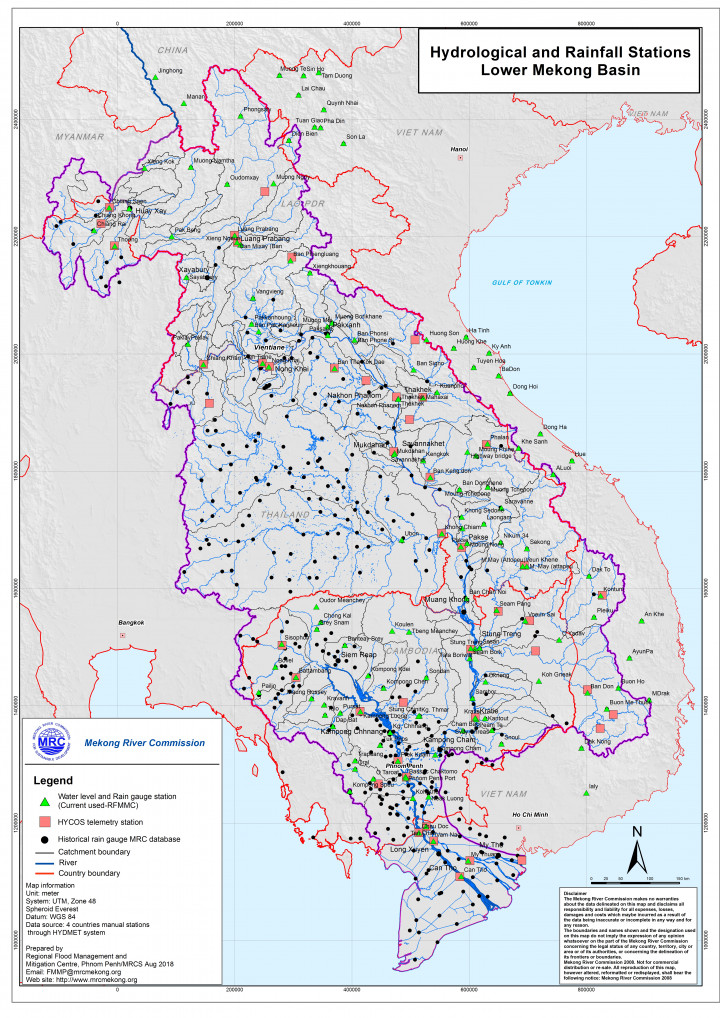
Flood and Drought Forecasting
Mekong floods bring benefits and costs. The Mekong annual flood rejuvenates wetlands and breeding grounds for aquatic plants, fish and animals, all of which are vital sources of income and food, particularly for poor communities. The annual flood also enriches soils with river-borne sediments and nutrients beneficial to agriculture, and replenishes reservoirs against water shortages in the dry season. The average annual value of flood benefits in the Lower Mekong River Basin (LMB) is approximately US$8-10 billion.
Floods become disasters when they are deeper than average, unexpectedly fast at their onset, or unusually prolonged. Flooding of the Mekong River and its tributaries are recurrent events. Each year it causes in varying degree of damage to agriculture, rural infrastructure, residential areas and essential services. It also endangers the lives of humans and has negative impacts on the environment. The annual cost of floods ranges from US$60-70 million.
The cost of droughts in the LMB dwarfs the cost of floods. Furthermore, unlike floods, droughts provide no apparent benefit. Droughts, which occur as a result of periods of very low river flow accompanied by low rainfall, can cause severe food shortages, damage the environment for animal lives, lead to poor biodiversity for aquatic lives, bank erosion, salinity intrusion and health problems for household communities due to contaminated water quality. Yields of rice and other lifeline crops plummet as a result of water shortages. Annual fish catches decline. Water levels become critically low, making transport of goods and services at some parts of the river difficult and at other points impossible.
Climate change, rapid urbanisation and environmental degradation further expose riverine communities, especially the poor and vulnerable, to greater risks.
Many regional, national, and local initiatives in the LMB have been carried out to reduce the risk of and vulnerability to floods and droughts. These efforts include huge investments in structural measures, such as flood and drought control reservoirs and detention basins, which are helpful but often have proved inadequate.
Preparedness and response measures for floods and droughts are highly dependent on the availability of accurate and timely meteorological and hydrological forecasting products and their effective and timely dissemination to both authorities and the public. The MRC, therefore, has been giving priority to forecasting and warning systems, providing the Member Countries with a range of information, forecasts and decision-support tools to better prepare for, monitor and respond to flood and drought risks.
Since the enormous flood of 1996, the MRC has been monitoring hydrologic conditions in the LMB to provide forecasting and warning services for flood conditions in the basin. The services are one of the MRC’s five Core River Basin Management Functions (CRBMF).
In 2006, the MRC established the Regional Flood Management and Mitigation Centre (RFMMC). The Centre serves as the MRC’s lead entity in delivering flood forecasting services, and in early 2019 was renamed ‘the Regional Flood and Drought Management Centre (RFDMC)’ to reflect an expansion in the range of services it provides.
The renaming signified the MRC’s efforts to address both flood and drought issues in an integrated manner and to provide faster and accurate forecasting and early warning information throughout the year.
The RFDMC services fall under four main activities: 1) river flow monitoring; 2) river flood forecasting; 3) flash flood guidance; and 4) drought forecasting and early warning.
Forecasting and Early Warning (flood and drought)
River Flow Monitoring and Flood Early Warning System
The MRC conducts river level monitoring in the dry season and forecasting in the wet season (rainfall and water level) year-round, providing observations and forecasts. The MRC Forecasting System consists of three main components: data collection and transmission; forecast operation; and forecast dissemination.
During the wet season (June to October), the RFDMC issues daily flood forecasts and warnings. Data from 138 hydro-meteorological stations, including two stations in China, is used to predict water levels at 22 forecast points on the Mekong mainstream. Daily bulletins are published on the MRC home page and dedicated Flood Forecasting Website and shared with the National Mekong Committees and line agencies of the four Member Countries, non-governmental organisations and the media. In turn, these agencies disseminate the information to a wider audience at national, sub-national and local levels.
Flash Flood Guidance System
Flash floods have a different character than river floods, notably short time scales and occurring in small spatial scales. Recognising that flash floods have a particularly disastrous impact on lives and properties of the affected communities in the LMB, the MRC in 2009 launched the flash floods guidance system (FFGS), which has since been operated at the RFDMC. The FFGS provides operational forecasters and disaster management agencies with real-time informational guidance products pertaining to the threats of small-scale flash flooding.
During the wet season from June to October, the RFDMC provides flash flood guidance information twice per day. Information on flash flood risk areas is shared with the Member Countries and published on the MRC Flood Forecasting Website.
Drought Forecasting and Early Warning System
During the dry season (November to May), weekly water levels and flows monitoring is provided, and weekly and monthly drought forecasting analyses are prepared and disseminated. As low water level monitoring is important in the dry season, the RFDMC provides a daily hydrograph of water levels comparing current levels to long-term averages.
Dissemination of Information and Forecasts
The MRC maintains the following websites to communicate to the Member Countries, stakeholders, and the public, providing historical and near-real time data on rainfall and water levels, drought monitoring data, and flood and drought forecasting bulletins, reports, and other advisories.
- Near Real-Time Monitoring (HYCOS)
- Flood Forecasting Website
- Drought Forecasting And Early Warning Website
As part of the initiative to improve the MRC's data, information, modelling, forecasting and communication systems, the visualisation of near-real time hydro-meteorological monitoring and flood and drought forecasts has been upgraded using interactive graphs and maps. This has enhanced the quality and effectiveness of reporting, more clearly illustrating the magnitude and extent of flood or drought conditions. This in turn has led to the more mainstream use of these services by relevant agencies in the Member Countries, as well as news agencies and social media.
Water Flow Monitoring
Hydrological flow regimes in the Mekong mainstream are illustrated by recorded water levels at key stations: at Chiang Saen to capture mainstream flows entering from the Upper Mekong River Basin; at Vientiane to show flows generated by climate conditions in the upper part of the LMB; at Pakse to investigate flows influenced by inflows from the Mekong major tributaries; at Kratie to capture overall flows of the Mekong River Basin; and at Phnom Penh to monitor flows to the Viet Nam Delta.
Maintaining water flow conditions, including relating to flood and drought, is one of the MRC’s core functions. Through the MRC’s Procedures for the Maintenance of Flows on the Mainstream (PMFM), the Member Countries have agreed to: (i) to maintain of not less than the acceptable minimum monthly natural flow during each month of the dry season; (ii) to enable the acceptable natural reverse flow of the Tonle Sap River to take place during the wet season; and (iii) to prevent average daily peak flows greater than what naturally occur on the average during the wet season. Four assessment indicators have been defined:
- Compliance of dry season flows with the PMFM
- Compliance of flood season flows with the PMFM
- Compliance of Tonle Sap reverse flows with the PMFM
- Change in the timing of onset of wet season flows
Accurate measurement of flows is challenging, especially in complex river sections where bank erosion and sedimentation occur. Also, flow measurement in sections under tidal influence and the reversal flow system below Tonle Sap are virtually impossible. Over recent years, the MRC Secretariat has made substantial efforts to improve the flow monitoring system.
